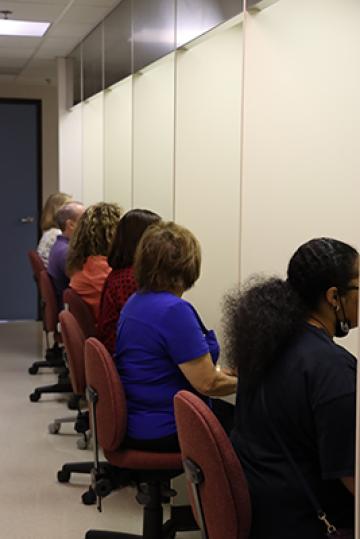Feeding the Most Sensitive Lab Equipment

Sensory Evaluation Lab panelists evaluate products in sensory booths. (Photo by Jeanne Lea)
The Agricultural Research Service (ARS) employs some of the world’s latest, greatest, and most sensitive laboratory equipment. And, while every scientist has a favorite “toy,” one scientist is putting his research where his mouth is.
For Ryan Ardoin, it’s human taste buds that provide the metrics that matter. That’s because Ardoin oversees a group of people known as a “sensory panel” – taste-testers who provide a human perspective on food characteristics.
“Sensory research is important to any project where the final product is intended for human consumption,” said Ardoin, a research food technologist at the ARS Southern Regional Research Center (SRRC)’s Sensory Evaluation Lab (SEL) in New Orleans, LA. “The sensory panel is a critical part of our research because analytical instrumentation can’t truly tell us what people experience from a food product. Only people can do that.”
Much of the SRRC’s work deals with improving the flavor or cooking performance of existing foods, creating new ones, recovering the economic vitality of a once-thriving commodity, and helping address food security and health issues. Recent successes include adding fiber and antioxidants from sorghum bran to gluten-free bread without compromising quality, and using that same sorghum bran to make a cold-brewed beverage with antioxidant activity.
The most modern lab equipment may measure the physical components of a food item, but it’s not great at determining how the taste or texture land on the human palette.
“All of [our food] projects involve having panelists evaluate the products,” Ardoin said. “They can tell us how similar or different samples are, and we can run tests with consumers to find out which products they prefer and why.”
While the SRRC does have a few human taste-testers on staff, most are residents of the New Orleans area. These panelists receive many hours of training to familiarize them with the basic elements of food products. They then learn to use a 15-point universal scale to rate these attributes consistently.
In essence, they are trained to ignore personal preference.
“Personal preference is definitely subjective,” he said. “We ask [our trained tasters] to forget about their personal preferences and concentrate on the intensities of food attributes. This type of work is called descriptive sensory analysis. We basically train people to be instruments to detect key flavor, aroma, and texture attributes.”
Consumers set the bar for a product’s taste and texture acceptance or rejection thresholds. At that point, testing can be turned over to trained panelists to put numbers on the attributes.
“When it comes to personal preference [in the consumer group] there is no ‘right’ or ‘wrong’ answer; everyone’s opinion is just as valid,” Ardoin said. “We want users of the product to be in our consumer panels and we want them to give us their honest opinions.”
Ardoin explained that the SEL uses one of the most popular methods of quantifying a product’s acceptability, a method known as the “hedonic scale.” The scale is a numeric rating in which the lowest number equals the least satisfaction, and the highest number reflects the most satisfaction. The method provides a clear, easy way for consumers to show how much they like or dislike a sample.
“We need to try products as we develop them and need to serve samples to our panelists,” Ardoin said. “If any new food product or technology is going to be successful, we have to understand how people perceive it, and that’s where we come in.” – by Scott Elliott, ARS Office of Communications

